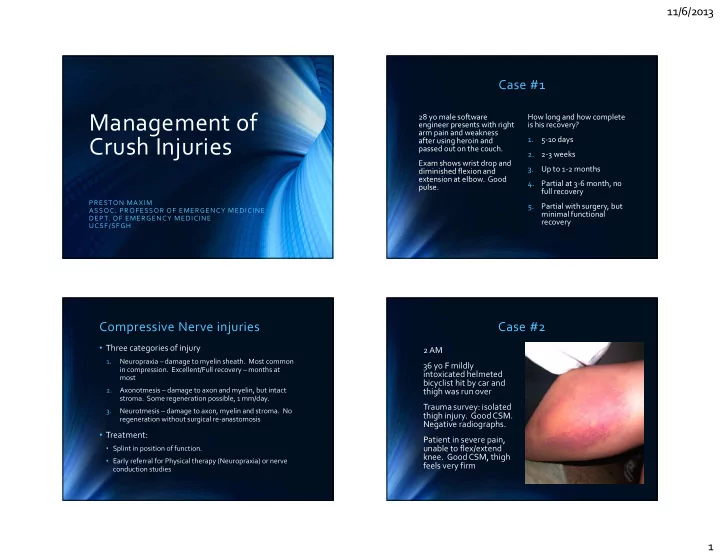

11/6/2013 Case #1 28 yo male software How long and how complete Management of engineer presents with right is his recovery? arm pain and weakness 1. 5-10 days after using heroin and Crush Injuries passed out on the couch. 2. 2-3 weeks Exam shows wrist drop and 3. Up to 1-2 months diminished flexion and extension at elbow. Good 4. Partial at 3-6 month, no pulse. full recovery PRESTON MAXIM 5. Partial with surgery, but ASSOC. PROFESSOR OF EMERGENCY MEDICINE minimal functional DEPT. OF EMERGENCY MEDICINE recovery UCSF/SFGH Compressive Nerve injuries Case #2 • Three categories of injury 2 AM 1. Neuropraxia – damage to myelin sheath. Most common 36 yo F mildly in compression. Excellent/Full recovery – months at intoxicated helmeted most bicyclist hit by car and 2. Axonotmesis – damage to axon and myelin, but intact thigh was run over stroma. Some regeneration possible, 1 mm/day. Trauma survey: isolated 3. Neurotmesis – damage to axon, myelin and stroma. No thigh injury. Good CSM. regeneration without surgical re-anastomosis Negative radiographs. • Treatment: Patient in severe pain, • Splint in position of function. unable to flex/extend knee. Good CSM, thigh • Early referral for Physical therapy (Neuropraxia) or nerve feels very firm conduction studies 1
11/6/2013 Compartment Syndrome Case #2 Continued • Do you: Call Ortho re: concern for compartment syndrome. CLASSIC FINDINGS CLINICAL FINDINGS 1. Give pain meds and discharge home in an You are told, ‘the patient is ambulance with return • Pain • Pain out of proportion drunk and drug seeking. precautions There is no fracture, good 2. Give pain meds, follow distal pulses, good distal • Pressure • Pain with passive serial exams and wait sensation. She does not for a new movement have compartment resident/attending in • Paresthesias syndrome and it would be the morning • Woody feeling malpractice to check her 3. Admit her to the • Paralysis compartment pressures. Medicine service for Control her pain, and if you pain control can’t, admit her to • Poikilothermia 4. Check her compartment Medicine.’ pressure • Pulselessness Compartment Pressure Compartment syndrome • Compartment numbers: • Continuous • Pressure > 30-45 require compartment fasciotomies monitoring in the at • High rate unnecessary risk obtunded patient fasciotomy • Delayed diagnosis • ACS Delta pressure increases morbidity (Diastolic – • Limb should be kept at compartment pressure): the level of the heart • Less than 30 mm Hg – (no elevation) fasciotomy • Only treatment is • Greater than 30 mm Hg – surgical trend for 6 hours 2
11/6/2013 Case #3 Earthquakes Experience • All retrospective observational data • You reply: Medics call: 35 M • 15-20% of earthquake crush injury victims develop 1. No pain meds, it is traumatic rhabdomyolysis construction worker helping maintain his crushed under cinderblock • 30-50% of those develop crush syndrome – shock and BP wall from waist down. renal failure 2. Give pain meds alone A&O times 3. • CK > 75,000 – 84% dialysis 3. Give pain meds and BP = 120/40 HR = 90 500 cc of NS • CK < 75,000 – 39% dialysis 4. Give pain meds and 2 10/10 pain after 10 mg • Early aggressive hydration can decrease the rate of liters NS Morphine. Want more renal failure to ~7% (Bam, Iran 2003) 5. Give pain meds and 2 pain meds • Bimodal survival relative to extrication time – high early liters of LR and late Traumatic Rhabdomyolysis • Clinical manifestation: Fluid • Pain from muscle injury Management and/or compartment syndrome of crush • Hypovolemia victims • Dark Urine • Renal insufficiency Early aggressive hydration is the key to preventing downstream renal failure 3
11/6/2013 Fluid Resuscitation and Traumatic Rhabdomyolysis monitoring • Creatinine Kinase – • Initial fluid resuscitation with NS – 2 liters comarker for myoglobin • Theoretic benefit of alkalinization: • Screen with CK and Urine dip – short myoglobin half- • 1 liter ½ NS with 50 meq sodium bicarbonate alternated life with 1-2 liters of NS • CK starts to rise ~2 hours after injury, peaks 24-72 • Goal urine pH > 6.5 hours • No proven benefit • Elevated CK and Myoglobin lead to heme induced ATN • Goal urine output of 200-300 ml/hr • CK > 5000 – rhabdomyolysis • Majority of patients develop hyperkalemia • ATN unlikely if CK < 15,000 Conclusion • Discussed management of nerve crush injuries • Splinting in position of function and early referral • Discussed compartment syndrome • High index of suspicion • Under-reliance on classic findings, rather serial exams and clinical findings (pain, pain with passive motion and firmness) • Early use of pressure manometer • Discussed Crush syndrome • Early aggressive hydration • Follow CK levels and anticipate/expect hyperkalemia 4
Recommend
More recommend